maven(私库)上传jar包
在实际开发过程中,我们经常会遇到需要引用的jar依赖,在我们公司的maven仓库不存在,这个时候我们就需要把jar上传上去,在项目中添加对应依赖就OK了。
步骤1:下载jar
在http://mvnrepository.com/中找到所需jar包,或者在其它地方下载对应jar包。
步骤2:添加仓库
打开maven仓库视图界面,登录(一般是用管理员用户),点击左边的Repositories,找到Third Party,检查如图所示配置。
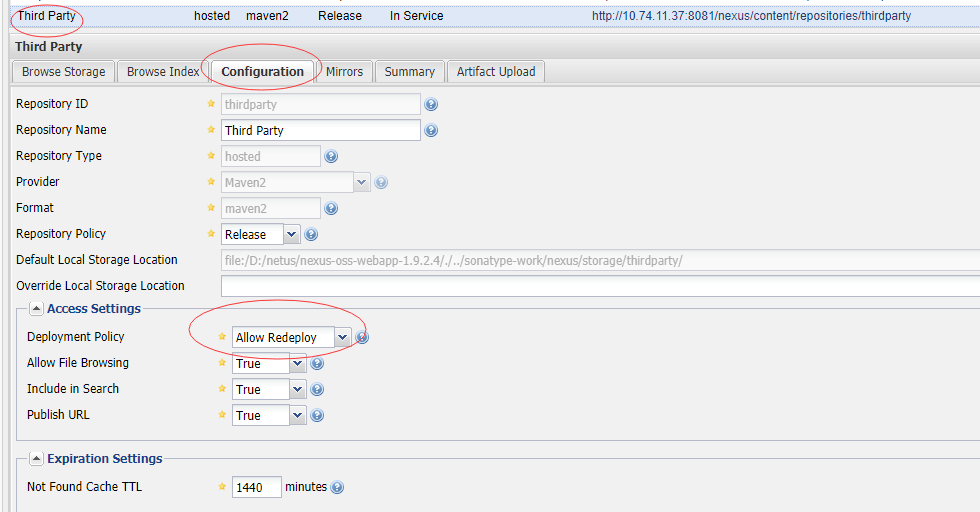
步骤三:上传jar
点击Artifact Upload,GAV Definition选择GAV Parameters,然后填上必要信息,参照下面2图。
前:
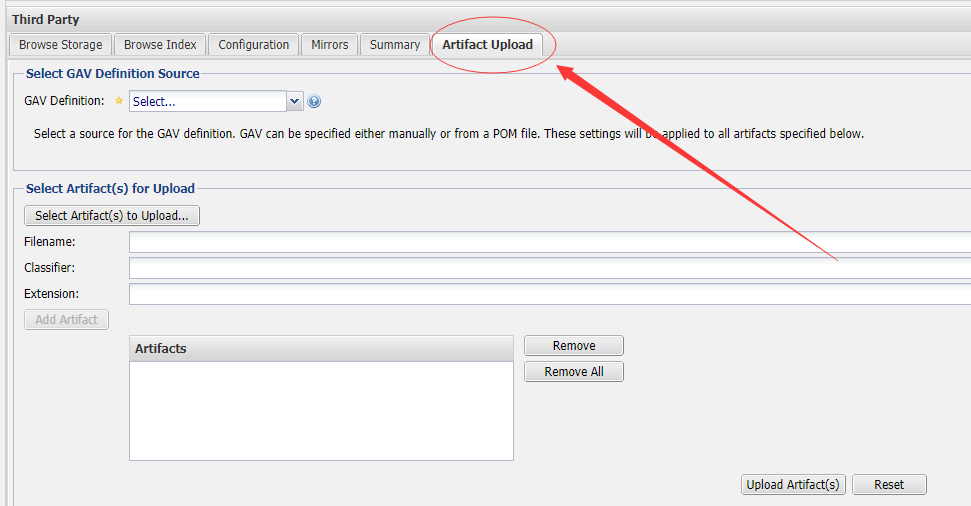
后:
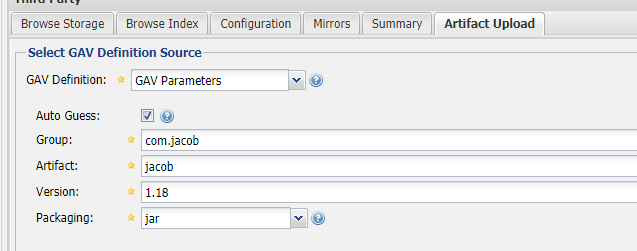
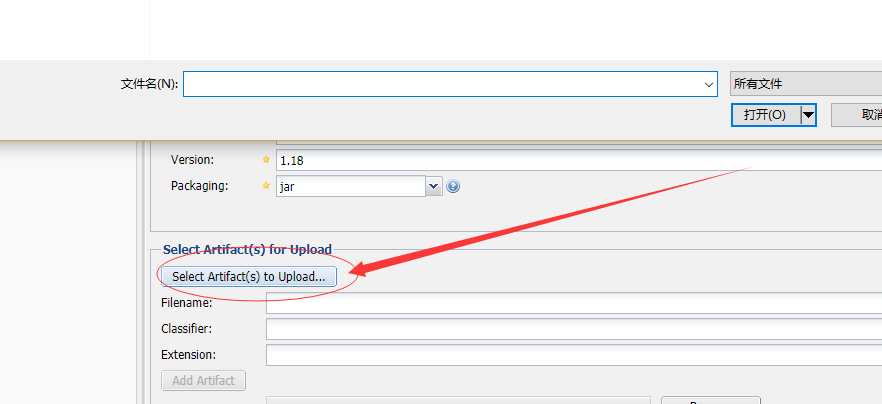
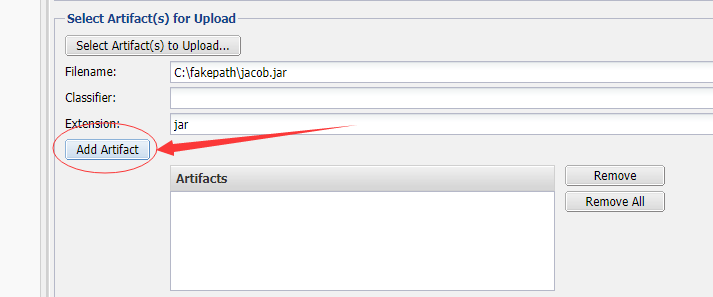
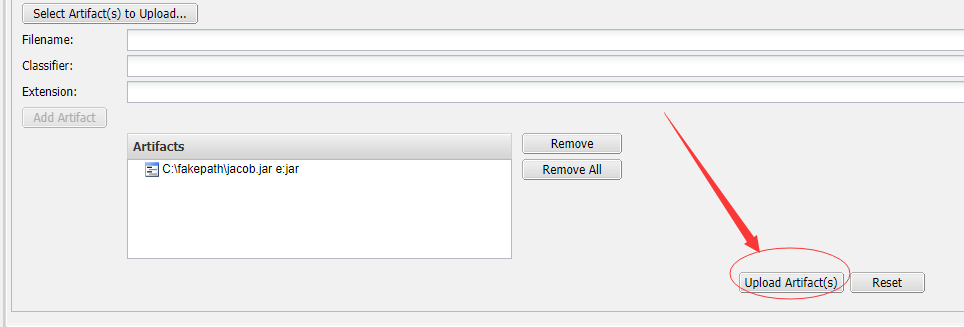
这样jar就上传到Third Party了。
但是,这样还不够,需要再检查一个东西
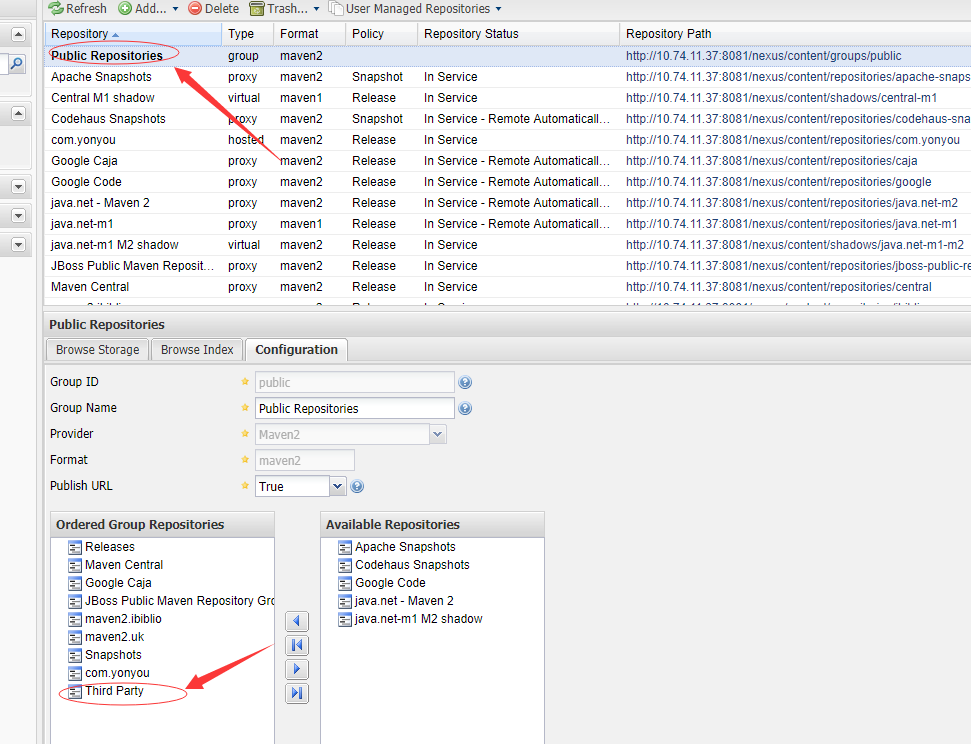
,这样就行了,还不够,要去maven的conf里设置下settings文件里面的server,附上我的settings.xml配置文件

<?xml version="1.0" encoding="UTF-8"?> <!--
Licensed to the Apache Software Foundation (ASF) under one
or more contributor license agreements. See the NOTICE file
distributed with this work for additional information
regarding copyright ownership. The ASF licenses this file
to you under the Apache License, Version 2.0 (the
"License"); you may not use this file except in compliance
with the License. You may obtain a copy of the License at http://www.apache.org/licenses/LICENSE-2.0 Unless required by applicable law or agreed to in writing,
software distributed under the License is distributed on an
"AS IS" BASIS, WITHOUT WARRANTIES OR CONDITIONS OF ANY
KIND, either express or implied. See the License for the
specific language governing permissions and limitations
under the License.
--> <!--
| This is the configuration file for Maven. It can be specified at two levels:
|
| 1. User Level. This settings.xml file provides configuration for a single user,
| and is normally provided in ${user.home}/.m2/settings.xml.
|
| NOTE: This location can be overridden with the CLI option:
|
| -s /path/to/user/settings.xml
|
| 2. Global Level. This settings.xml file provides configuration for all Maven
| users on a machine (assuming they're all using the same Maven
| installation). It's normally provided in
| ${maven.home}/conf/settings.xml.
|
| NOTE: This location can be overridden with the CLI option:
|
| -gs /path/to/global/settings.xml
|
| The sections in this sample file are intended to give you a running start at
| getting the most out of your Maven installation. Where appropriate, the default
| values (values used when the setting is not specified) are provided.
|
|-->
<settings xmlns="http://maven.apache.org/SETTINGS/1.0.0"
xmlns:xsi="http://www.w3.org/2001/XMLSchema-instance"
xsi:schemaLocation="http://maven.apache.org/SETTINGS/1.0.0 http://maven.apache.org/xsd/settings-1.0.0.xsd">
<!-- localRepository
| The path to the local repository maven will use to store artifacts.
|
| Default: ${user.home}/.m2/repository
<localRepository>/path/to/local/repo</localRepository>
--> <!-- interactiveMode
| This will determine whether maven prompts you when it needs input. If set to false,
| maven will use a sensible default value, perhaps based on some other setting, for
| the parameter in question.
|
| Default: true
<interactiveMode>true</interactiveMode>
--> <!-- offline
| Determines whether maven should attempt to connect to the network when executing a build.
| This will have an effect on artifact downloads, artifact deployment, and others.
|
| Default: false
<offline>false</offline>
--> <!-- pluginGroups
| This is a list of additional group identifiers that will be searched when resolving plugins by their prefix, i.e.
| when invoking a command line like "mvn prefix:goal". Maven will automatically add the group identifiers
| "org.apache.maven.plugins" and "org.codehaus.mojo" if these are not already contained in the list.
|-->
<pluginGroups>
<!-- pluginGroup
| Specifies a further group identifier to use for plugin lookup.
<pluginGroup>com.your.plugins</pluginGroup>
-->
<pluginGroup>com.alibaba.org.apache.maven.plugins</pluginGroup>
<pluginGroup>com.alibaba.maven.plugins</pluginGroup>
<pluginGroup>org.mortbay.jetty</pluginGroup>
<pluginGroup>org.codehaus.cargo</pluginGroup>
<pluginGroup>org.apache.maven.plugins</pluginGroup>
<pluginGroup>org.codehaus.mojo</pluginGroup>
</pluginGroups> <!-- proxies
| This is a list of proxies which can be used on this machine to connect to the network.
| Unless otherwise specified (by system property or command-line switch), the first proxy
| specification in this list marked as active will be used.
|-->
<proxies>
<!-- proxy
| Specification for one proxy, to be used in connecting to the network.
|
<proxy>
<id>optional</id>
<active>true</active>
<protocol>http</protocol>
<username>proxyuser</username>
<password>proxypass</password>
<host>proxy.host.net</host>
<port>80</port>
<nonProxyHosts>local.net|some.host.com</nonProxyHosts>
</proxy>
-->
</proxies> <!-- servers
| This is a list of authentication profiles, keyed by the server-id used within the system.
| Authentication profiles can be used whenever maven must make a connection to a remote server.
|-->
<servers>
<!-- server
| Specifies the authentication information to use when connecting to a particular server, identified by
| a unique name within the system (referred to by the 'id' attribute below).
|
| NOTE: You should either specify username/password OR privateKey/passphrase, since these pairings are
| used together.
|
<server>
<id>deploymentRepo</id>
<username>repouser</username>
<password>repopwd</password>
</server>
--> <!-- Another sample, using keys to authenticate.
<server>
<id>siteServer</id>
<privateKey>/path/to/private/key</privateKey>
<passphrase>optional; leave empty if not used.</passphrase>
</server>
-->
<server>
<id>nexus-releases</id>
<username>admin</username>
<password>mtait</password>
</server> <server>
<id>nexus-snapshots</id>
<username>admin</username>
<password>mtait</password>
</server> <server>
<id>nexus</id>
<username>admin</username>
<password>mtait</password>
</server> <server>
<id>tomcat.server</id>
<username>mtait</username>
<password>mtait</password>
</server>
</servers> <!-- mirrors
| This is a list of mirrors to be used in downloading artifacts from remote repositories.
|
| It works like this: a POM may declare a repository to use in resolving certain artifacts.
| However, this repository may have problems with heavy traffic at times, so people have mirrored
| it to several places.
|
| That repository definition will have a unique id, so we can create a mirror reference for that
| repository, to be used as an alternate download site. The mirror site will be the preferred
| server for that repository.
|-->
<mirrors>
<!-- mirror
| Specifies a repository mirror site to use instead of a given repository. The repository that
| this mirror serves has an ID that matches the mirrorOf element of this mirror. IDs are used
| for inheritance and direct lookup purposes, and must be unique across the set of mirrors.
|
<mirror>
<id>mirrorId</id>
<mirrorOf>repositoryId</mirrorOf>
<name>Human Readable Name for this Mirror.</name>
<url>http://my.repository.com/repo/path</url>
</mirror>
-->
<mirror>
<id>nexus</id>
<name>Nexus Public Mirror</name>
<!--<url>http://maven.aliyun.com/nexus/content/groups/public/</url>-->
<url>http://10.74.11.37:8081/nexus/content/groups/public</url>
<mirrorOf>*</mirrorOf>
</mirror>
</mirrors> <!-- profiles
| This is a list of profiles which can be activated in a variety of ways, and which can modify
| the build process. Profiles provided in the settings.xml are intended to provide local machine-
| specific paths and repository locations which allow the build to work in the local environment.
|
| For example, if you have an integration testing plugin - like cactus - that needs to know where
| your Tomcat instance is installed, you can provide a variable here such that the variable is
| dereferenced during the build process to configure the cactus plugin.
|
| As noted above, profiles can be activated in a variety of ways. One way - the activeProfiles
| section of this document (settings.xml) - will be discussed later. Another way essentially
| relies on the detection of a system property, either matching a particular value for the property,
| or merely testing its existence. Profiles can also be activated by JDK version prefix, where a
| value of '1.4' might activate a profile when the build is executed on a JDK version of '1.4.2_07'.
| Finally, the list of active profiles can be specified directly from the command line.
|
| NOTE: For profiles defined in the settings.xml, you are restricted to specifying only artifact
| repositories, plugin repositories, and free-form properties to be used as configuration
| variables for plugins in the POM.
|
|-->
<profiles>
<!-- profile
| Specifies a set of introductions to the build process, to be activated using one or more of the
| mechanisms described above. For inheritance purposes, and to activate profiles via <activatedProfiles/>
| or the command line, profiles have to have an ID that is unique.
|
| An encouraged best practice for profile identification is to use a consistent naming convention
| for profiles, such as 'env-dev', 'env-test', 'env-production', 'user-jdcasey', 'user-brett', etc.
| This will make it more intuitive to understand what the set of introduced profiles is attempting
| to accomplish, particularly when you only have a list of profile id's for debug.
|
| This profile example uses the JDK version to trigger activation, and provides a JDK-specific repo.
<profile>
<id>jdk-1.4</id> <activation>
<jdk>1.4</jdk>
</activation> <repositories>
<repository>
<id>jdk14</id>
<name>Repository for JDK 1.4 builds</name>
<url>http://www.myhost.com/maven/jdk14</url>
<layout>default</layout>
<snapshotPolicy>always</snapshotPolicy>
</repository>
</repositories>
</profile>
--> <!--
| Here is another profile, activated by the system property 'target-env' with a value of 'dev',
| which provides a specific path to the Tomcat instance. To use this, your plugin configuration
| might hypothetically look like:
|
| ...
| <plugin>
| <groupId>org.myco.myplugins</groupId>
| <artifactId>myplugin</artifactId>
|
| <configuration>
| <tomcatLocation>${tomcatPath}</tomcatLocation>
| </configuration>
| </plugin>
| ...
|
| NOTE: If you just wanted to inject this configuration whenever someone set 'target-env' to
| anything, you could just leave off the <value/> inside the activation-property.
|
<profile>
<id>env-dev</id> <activation>
<property>
<name>target-env</name>
<value>dev</value>
</property>
</activation> <properties>
<tomcatPath>/path/to/tomcat/instance</tomcatPath>
</properties>
</profile>
-->
<profile>
<id>nexus</id>
<repositories>
<repository>
<id>central</id>
<url>http://central</url>
<releases>
<enabled>true</enabled>
</releases>
<snapshots>
<enabled>true</enabled>
</snapshots>
</repository>
</repositories>
<pluginRepositories>
<pluginRepository>
<id>central</id>
<url>http://central</url>
<releases>
<enabled>true</enabled>
</releases>
<snapshots>
<enabled>true</enabled>
</snapshots>
</pluginRepository>
</pluginRepositories>
</profile>
<profile>
<id>sonatype</id>
<repositories>
<repository>
<id>sonatype</id>
<name>oss.sonatype.org</name>
<url>https://oss.sonatype.org/content/repositories/snapshots/</url>
<releases>
<enabled>true</enabled>
</releases>
<snapshots>
<enabled>true</enabled>
</snapshots>
</repository>
</repositories>
</profile>
</profiles> <!-- activeProfiles
| List of profiles that are active for all builds.
|
<activeProfiles>
<activeProfile>alwaysActiveProfile</activeProfile>
<activeProfile>anotherAlwaysActiveProfile</activeProfile>
</activeProfiles>
-->
<activeProfiles>
<activeProfile>nexus</activeProfile>
<activeProfile>sonatype</activeProfile>
</activeProfiles>
</settings>

到此,上传至maven仓库的第三方jar就在你的中央仓库中了,项目就可以直接添加依赖引入了。
<dependency>
<groupId>com.jacob</groupId>
<artifactId>jacob</artifactId>
<version>1.18</version>
</dependency>
注意:groupId,artifactId,version是你刚才添加的内容。
maven(私库)上传jar包的更多相关文章
- Maven使用deploy上传jar包到远程库
一.环境准备 首先需要在本地环境安装好maven,并且在环境变量配置好 二.配置远程库认证 需要在./conf/setting.xml(maven的配置文件,不要弄错)中配置需要远程上传库的地址,用户 ...
- Maven使用deploy上传jar包到远程库 以Oracle驱动为例
一.首先要得到Oracle JDBC Driver 1.通过Oracle官方网站下载相应版本:http://www.oracle.com/technetwork/database/features/j ...
- Maven基础配置—上传jar包到私服
一.配置 在需要上传的工程中的pom.xml文件中加入下面的配置 <distributionManagement> <repository> <id>release ...
- 实测Maven上传jar包到私服的方法归纳
Hello,各位小伙伴大家好,我是小栈君.好久不见,最近因为工作的缘故,导致了更新变慢,但是小栈君也在积极的做素材的规划,毕竟学习知识点的归纳和提炼需要一定的时间. 所以还请大家多多见谅,下一期的分享 ...
- maven安装 maven上传jar包到库里面
maven的安装与配置:http://pansanday.blog.163.com/blog/static/381662802012727103454743/ maven上传jar包到库里面: 将私有 ...
- gradle上传jar包到maven公共仓库
首先这里说的中央仓库 是指的 https://issues.sonatype.org/ 而不是maven私服. 其次是使用gradle上传jar包,maven上传,网上有很多教程,这里不做赘述. 首选 ...
- Maven第四篇【私有仓库、上传jar包、引用私服jar包、上传本地项目到私服】
搭建私有服务器 前面已经说过了,我们使用Maven的使用,如果需要导入相对应的jar包,Maven首先会在我们的本地仓库中寻找->私有仓库->中心仓库- 然而,我们的本地仓库常常没有想要的 ...
- maven上传jar包到nexus私服后的存放路径 以及 使用IDEA上传jar包的步骤
maven上传jar包到nexus私服的方法,网上大神详解很多,那么上传后的jar包存放到哪里了呢? 在下使用nexus3.2.1版本,在本地搭建了私服,使用maven上传jar包.最后结果如下: 点 ...
- Maven上传jar包到私服
1.认证,在M2_HOME/conf/settings.xml配置用户名密码 <server> <id>releases</id> <username> ...
随机推荐
- maven如何引入servlet-api和jsp-api
废话不多说,直接上代码 <dependency> <groupId>javax.servlet</groupId> <artifactId>javax. ...
- centos7 安装docker-ce ,最新版本docker,docker阿里云加速
直接用yum install docker -y安装的docker版本为1.12,但是docker发展很快,现在都17.06.2了.docker-ce是指docker的社区版 卸载老版本的 docke ...
- WWW.LoadFromCacheOrDownload
[WWW.LoadFromCacheOrDownload] static WWWLoadFromCacheOrDownload(string url, int version, uint crc = ...
- Spring Data JPA 参考指南 中文版
附下载地址:https://www.gitbook.com/book/ityouknow/spring-data-jpa-reference-documentation/details
- linux系统软件版本升级
在安装完软件之后,在同一层目录生成一个符号链接,并把当前软件的目录映射到这个链接上,后面的操作都只通过这个链接去做,以后升级版本的时候,把最新的软件目录映射到这个链接上就可以了. 如我刚装的apach ...
- CloudStack 4.3功能前瞻
今天CloudStack 4.3已经Feature Freeze了,不会再有新功能加入到这个版本里.我们也可以坐下来看看哪些功能是值得期待的.首先,4.3的UI也秉承扁平化设计,看着更加简洁清爽.见下 ...
- fastdfs 上传和下载 有用
一.FastDFS解决什么样的问题 1.存储空间可扩展. 2.提供一个统一的访问方式. 使用FastDFS,分布式文件系统.存储空间可以横向扩展,可以实现服务器的高可用.支持每个节点有备份机. 二.什 ...
- LoadRunner11学习记录五 -- 错误提示分析
LoadRunner测试结果具体分析: 一.错误提示分析 分析实例: 1.Error: Failed to connect to server “172.17.7.230″: [10060] Con ...
- Use formatter to format your JAVA code
In order to make the codes looks unified and make it easy to understand, it's better to use the same ...
- [Cookie] Clear Cookie
import com.eviware.soapui.impl.wsdl.support.http.HttpClientSupport def myCookies = testRunner.testCa ...
